The Razer DeathStalker Chroma Gaming Keyboard Review
by E. Fylladitakis on December 7, 2015 9:00 AM EST- Posted in
- Keyboard
- Razer
- RGB Backlighting
- chiclet
Quality Testing
In order to test the quality and consistency of a keyboard, we are using a texture analyser that is programmed to measure and display the actuation force of the standard keyboard keys. By measuring the actuation force of every key, the quality and consistency of the keyboard can be quantified. It can also reveal design issues, such as the larger keys being far softer to press than the main keys of the keyboard. The actuation force is measured in 'centinewton' (cN), or hundredths of a newton. Some companies use another figure, gram-force (gf). The conversion formula is 1 cN = 1.02 gf (i.e. they are about the same). A high quality keyboard should be as consistent as possible, with an average actuation force as near to the manufacturer's specs as possible and a disparity of less than ±10%. Greater differences are likely to be perceptible by users.
The machine we use for our testing is accurate enough to provide readings with a resolution of 0.1 cN. For wider keys (e.g. Enter, Space Bar, etc.), the measurement is taking place at the center of the key, right above the switch. Note that large keys generally have a lower actuation force even if the actuation point is at the dead center of the key. This is natural, as the size and weight of the keycap reduces the required actuation force. For this reason, we do display the force required to actuate every key but we only use the results of the typical sized keys for our consistency calculations. Still, very low figures on medium sized keys, such as the Shift and Enter keys reveal design issues and can easily be perceptible by the user.
We should start by clarifying that you should not directly compare the above results to a mechanical keyboard. The chiclet keys of the DeathStalker Chroma have a travel distance of just 2 mm and their maximum force point is at the very top of this distance. Furthermore, their performance and feeling are entirely different in comparison to mechanical keys. We performed the above testing to showcase the difference between chiclet and mechanical keys, as well as for future comparisons.
The chiclet keys of the DeathStalker Chroma are terribly consistent, with a disparity of just ±1.89%. Their average actuation force is 62 cN, which is relatively high for chiclet keys, but it also offers a feeling of firmness and precision. Unlike with mechanical keyboards, the actuation force of the larger keys (Space, Shift, Enter, etc.) is very close to that of the main keys. That is because the low profile keycaps have minimal weight and the travel distance is very short, which impede the weight of the keycap and or its momentum from assisting the actuation of the key. Technically, the actuation force difference between all keys is minimal and impossible to be perceived by touch.
The Razer Synapse Software
The DeathStalker Chroma requires the use of Razer's Synapse software in order to access its advanced features, such as key programming, profiles and lighting adjustments. Over a year ago, when we reviewed the BlackWidow Ultimate, the software was effective enough for that particular keyboard and it showed a lot of promise. However it would seem that the software has not evolved much during the past year, despite Razer's competition that has been working wonders with their own. Furthermore, the software requires the signup for a Razer Synapse account that involves email validation. One cannot simply download the software/drivers, install them and be done with it. It does have benefits, such as the saving of the programmed profiles to the cloud, but many feel that it intrudes their privacy. This has received the negative criticism of many users.
Perhaps the primary selling feature of the DeathStalker Chroma is that it is a fully programmable keyboard. However, the keyboard has no keys dedicated to profile switching, macros and or other advanced functions. Thus, it is of critical importance that the software can recognize the launch of applications/games and switch to a pre-programmed profile automatically. As the DeathStalker Chroma has no extra keys, the functions of the main keys have to be reprogrammed to offer in-game functions and macros. The Razer Synapse software does offer this feature and it works seamlessly. All of the keys can be reassigned to perform other functions than their standard intended purpose, from simple layout changes and mouse commands to complex macros and external software launches. However, if profile switching within a game is required, at least one key needs to be sacrificed and reprogrammed to cycle through profiles. This is required with online games, where repurposing the main keys of the keyboard will likely make the user unable to type text and chat with others.
While the Razer software has basic macro usage covered, users looking for more advanced control are going to come away disappointed. The macro recorder is severely outdated and limited, with the ability to record only keyboard keystrokes and delays. These are editable after the recording but only individually and other commands cannot be inserted manually. It cannot record mouse functions at all, let alone absolute on screen coordinates and more complex actions. By all means, this level of macro programming is not going to satisfy most advanced users, who will most definitely resort to third-party software for that.
Basic lighting effects can be programmed to each profile through the "Lighting" tab of the software. RGB programming requires to bring up the "Chroma Configurator", which brings up more advanced lighting programming options. The RGB configuration of the DeathStalker Chroma is forcefully reduced to three layers and per-key configuration is not possible. Each of the three layers can be programmed to a different color and or lighting effect, such as "breathing" or "cycling", but the brightness of all layers is universal. The software allows the user to pick any of the 16.8 million colors of the RGB scale, but we feel that the eight pre-programmed base colors will be more than enough for the vast majority of users.
Razer also included a feature called "Chroma Apps", where specific games and applications can interface with the Synapse software and provide customized lighting effects. Supported games, applications and profiles can be found at Razer's Workshop. The list is still very small, but it should grow over time.
Finally, the last tab hosts a recorder of usage statistics. By default, all recording is disabled. If enabled, the users can check how many keystrokes have performed, the travel distance of all these keystrokes, the number of profile switches and macros. The results can be filtered for individual games and time periods. It is not a functionally important feature, but it is fun.


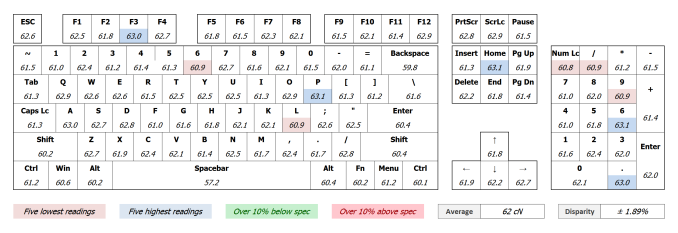

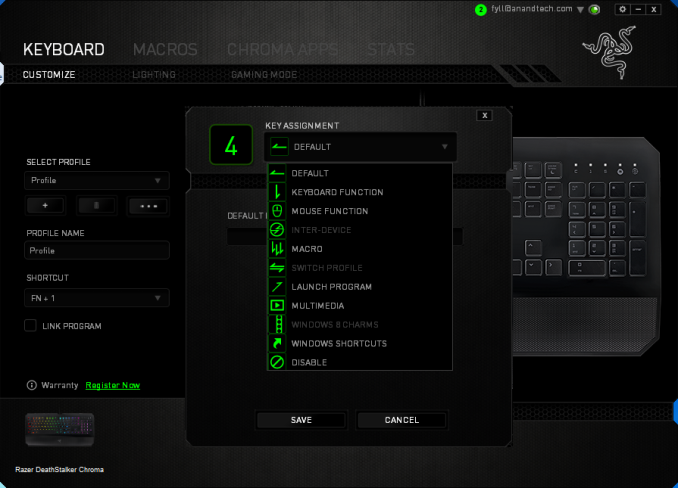
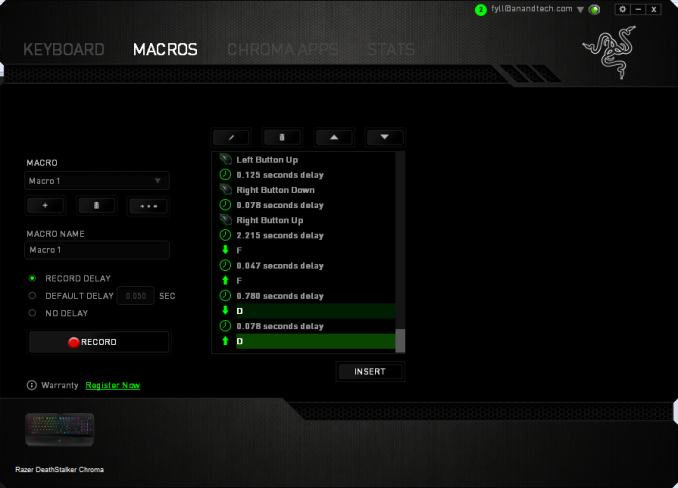
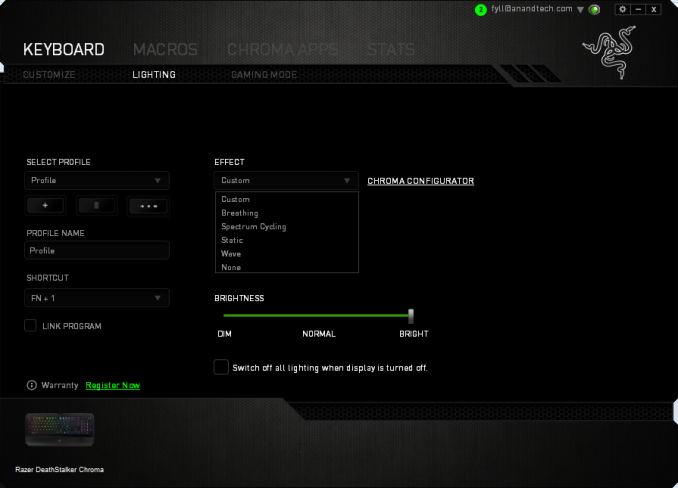

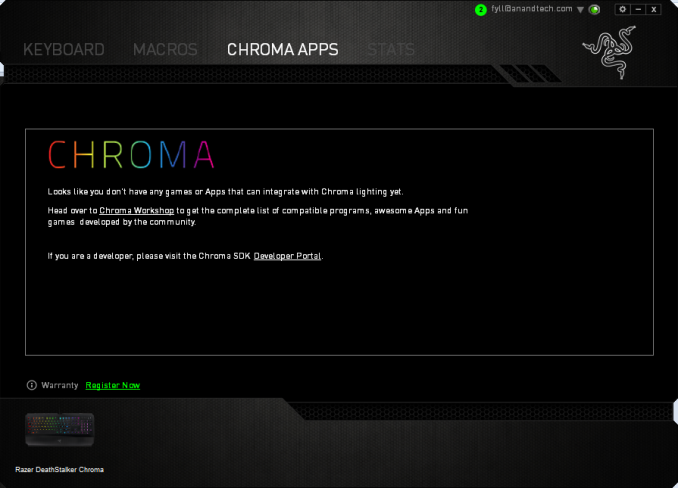
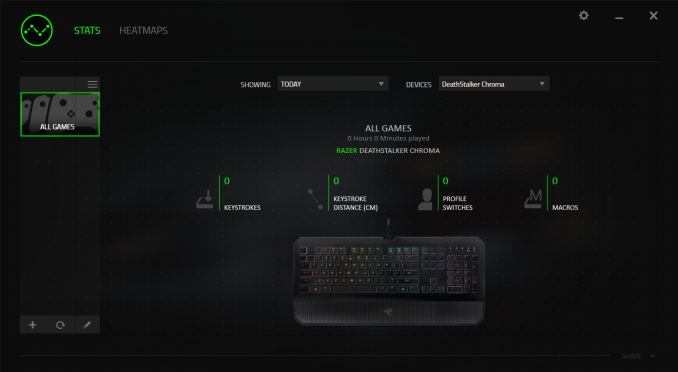








56 Comments
View All Comments
MrSpadge - Monday, December 7, 2015 - link
And if that doesn't work, colours wouldn't help either: you'd have to look down to assign the different colours popping up in your periphery vision to the precise keys they illuminate.Kakti - Monday, December 7, 2015 - link
I type well over 120 wpm - I've been using keyboards since the late 80's. My particular use case (I understand this won't apply for all) is playing with lights dimmed or off and using my peripheral vision to ensure I hit the correct key. For example I'm playing Witcher 2 right now, and the "signs" are keys 5-9. It'd be nice to have those as a different color so if I'm going for 7 in the middle, it's completely obvious which key 7 is. Likewise in Diablo 3 I accidently hit J instead of H many times, so in the middle of a battle I'm pulling up the damn journal or whatever instead of healing (I've since reassigned the key). The point is these RGB kb's have the potential to allow you to assign keys or groups of keys and have almost 100% accuracy in low light conditions.Again, I'm using my peripheral vision not actually changing my focus. Simply "blanking out" the orange key with my finger lets me know it's in the right spot. Putting several similar keys in a row will help you find the 2nd or 3rd, 4th easier, especially if that set of keys is on an "island" like 5-9.
YMMV
nugglets - Monday, December 7, 2015 - link
You must be able to slow time, because I can't imagine how you are able to type 120wpm but not consistently hit the right keys.That makes no logical sense whatsoever.
Kakti - Tuesday, December 8, 2015 - link
It's quite simple really, when I'm typing my fingers are anchored by the ridges of the F and J keys. When I'm gaming they are not - left hand can be on WASD or 1234, right hand is on the mouse. Knowing how to touch type writing paragraphs is completely different than hitting a single key when your hands are in an unusual place. WASD is a bit easier, for D3 where my left hand is on 1234 it's more difficult.Dr_Orgo - Monday, December 7, 2015 - link
Spoiler: RGB keyboards only purpose is to look cool. If you need to look down to find hotkeys while gaming you're doing it wrong or don't know how to rebind hotkeys. Even SC2 which uses >20 hotkeys with 3 modifiers can rebound to have all keys within easy reach. Google "tenkeyless otaku" for what a gaming keyboard looks like (if you don't like bling).BurntMyBacon - Monday, December 7, 2015 - link
@Kakti: " IMO the entire point of RGB keyboards is to allow one to set individual keys to different colors so you can hit it without looking down while gaming."Err. Maybe I'm missing something here, but what good does unique colors do you if you don't look at the colors. I'm going to assume you meant so that you don't have to look down longer than a glance to figure it out. Side Note: For those that don't want to look down at all, I recommend finding your home keys (the "F" and "J" keys have a small raised feature usually an underscore at the bottom of the key) and shifting one key out from there.
To support your point, though, RGB without individual lighting is only really useful to select the color of your backlight. I think a uniform backlight is useful, but I don't see any reason to pay for the full RGB treatment for a uniform backlight when there are some many non-RGB backlights that are cheaper. If I'm paying RGB pricing, I want my functionality.
jasonelmore - Monday, December 7, 2015 - link
Looks like this is just a software limitation, as all keys are capable of the full 16 million colors.. It will probably be added soon or by a 3rd party via the SDKpiiman - Saturday, December 12, 2015 - link
" individual keys to different colors so you can hit it without looking down while gaming. For example WASD all red, I is blue, H is green, M is yellow, etc"So how do you see the colors without looking at them?
ciparis - Monday, December 7, 2015 - link
In a lighted gaming keyboard, WASD (at a minimum) should be its own zone. Inexplicable oversight from a supposed gaming hardware company.Fallen Kell - Monday, December 7, 2015 - link
Once I saw chiclet keys, I stopped reading. I personally just can't stand them. I "deal" with them on a laptop only because there really isn't much of a choice (aside from the one laptop that has a mechanical keyboard).